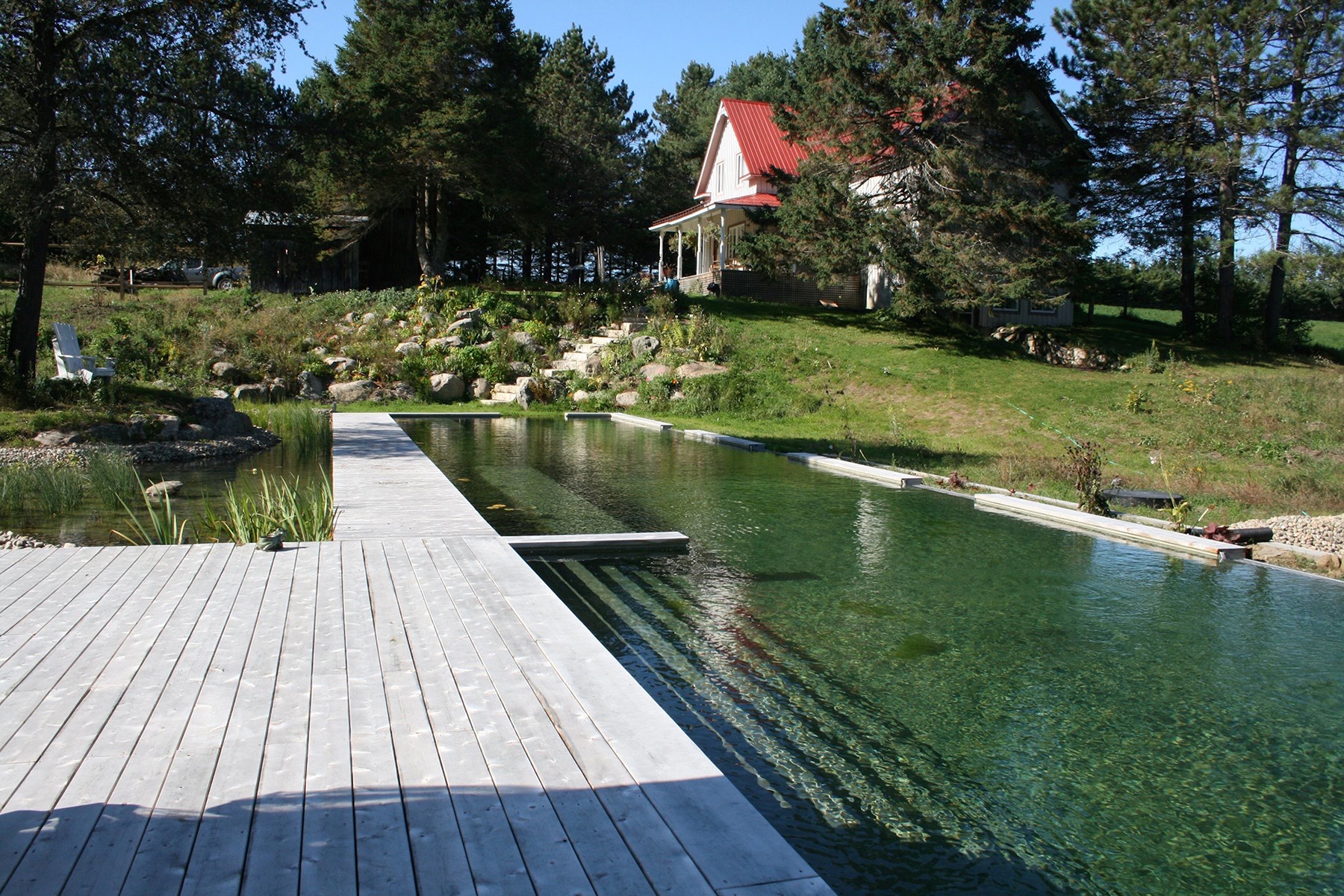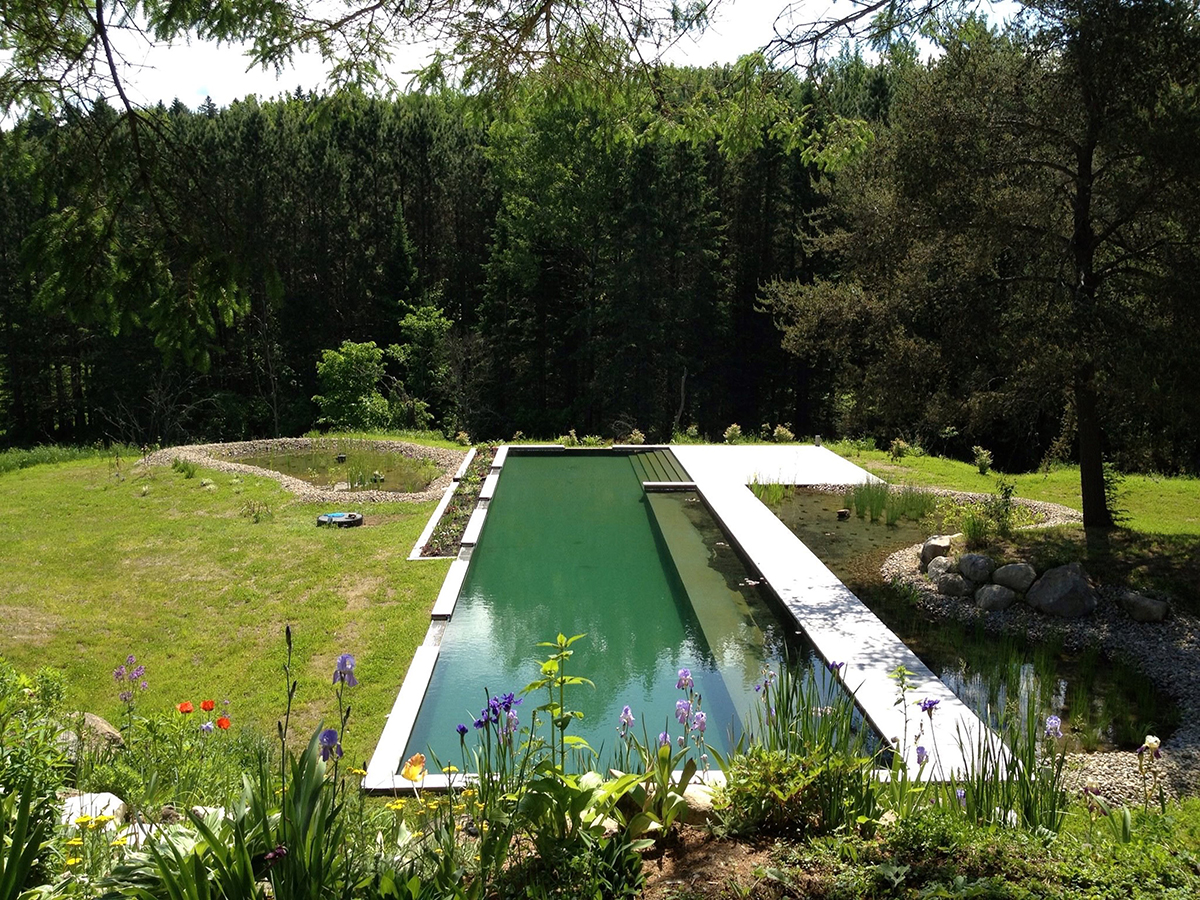Although they aren’t that popular in Québec, they are quite common in Europe. Some books deal with the subject there. You can even find videos on YouTube. Imagine! Swimming in a natural pool without chemical products. Out with the chlorine!

Jocelyn Lussier, an expert in the field of the company Topia, says: “The filtration area is composed of several layers of materials that will act as filters. The upper part will be composed of plants. The plantation zones are created in varying depths to adapt to the vegetation used for filtration, like oxygenating, purifying, floating and submerged plants and shoreline vegetation.”
It’s the plants that take care of filtering the water. The purification is done naturally. The water is so pure that you can almost drink it.
The purification process is done in a pool of water converted into a lagoon. That’s where the plants, like water lilies or others, accomplish their job of filtration. Then, the water spills into the swimming area through a waterfall or over a retaining wall. This is the oxygenation phase, which is then completed by certain plants. The water always circulates which keeps mosquitoes at bay since they are attracted to stagnant water. It’s the same principle as a mountain lake. Same simplicity, same freshness and the same pleasure to swim in.
Numerous healthy and sustainable materials ensure the pool’s impermeability. You can transform your conventional in-ground pool into an ecological pool. Among other things, you will have to build a natural purification and oxygenation zone and demolish one side of the pool to let the water fall into the swimming area.
Now, let’s talk about its location. It is preferable to orient the pool towards the south-west. Placing it facing south will promote algae growth. You also have to consider the prevailing winds to prevent cooler weather, especially knowing that the water temperature will be colder, around 75 degrees. Useless to say that orienting the pool towards the north is not recommended.

There are a few precautions to take. You should avoid having grass around the pool because swimmers will bring in grass clippings. A distance of 6 to 8 feet is recommended between the pool and big trees because of their long roots. The yard must be in good condition, well-drained and stable if the soil is clay. The use of sunscreen is not recommended. And watch the groundwater table!
The ecological pool often looks like a pond. From an aesthetic point of view, a natural look is usually adopted. The vegetation is chosen with care, resin stones or sand surround the pool, as many birds, butterflies and dragonflies.
It’s up to you to add decorative accessories without taking away from the natural look: a walkway over the pool, rocks intended as a seating area, a wooden bench.
Ecological pools might rebuff a few. Some people refuse to swim with frogs, snails and other aquatic animals. In addition, the bottom of the pool will eventually be covered with a thin coat of vegetation that may be unpleasant and sometimes slippery.
Some argue that the cost of an ecological pool is roughly the same as that of an artificial pool. Jocelyn Lussier, of Topia, is not convinced: “It costs more because the filtration area is equal to the area reserved for swimming. Therefore, you’ll need the surface of two pools for one alone.”
The cost of an ecological pool is about the same as an artificial pool. There is barely any maintenance apart from cutting the plants in the fall, covering the pool from the falling leaves and draining the filtration pipes before winter.
The Écohabitation website explains everything in detail: its conception, construction and design. We also recommend the two books below. You’ll be glad to find all the necessary info and you will see that there are many variables to ecological pools.
References:
- Léopold Franck (2014). Les écopiscines, l’ultime révolution en piscine écologique (pp. 81). Cérès Éditions.
- Marie-Pierre Dubois Petroff (2011). Les piscines classiques ou naturelles (pp. 169), Éditions Massin.
Images: iStock.com and Topia
